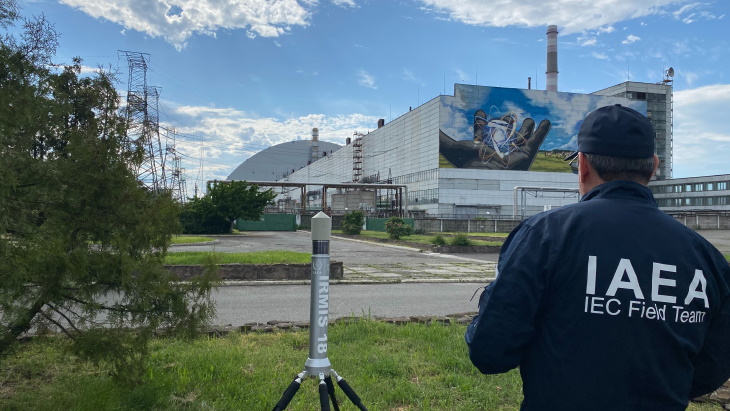IAEA completes follow-up mission to Chernobyl
06 June 2022
The International Atomic Energy Agency (IAEA) last week concluded a mission to the Chernobyl nuclear power plant in Ukraine and the surrounding Exclusion Zone after carrying out planned nuclear safety, security and safeguards activities there. IAEA Director General Rafael Mariano Grossi said he is trying to organise a mission to the Zaporizhzhia plant, which remains under the control of Russian military forces.
 One of the IAEA team at the Chernobyl plant (Image: IAEA)
One of the IAEA team at the Chernobyl plant (Image: IAEA)
The technical follow-up mission - the IAEA's second to the Chernobyl site in the past six weeks - was part of efforts to help ensure nuclear safety and security in Ukraine during the current military conflict. Ukraine, which also has four operating nuclear power plants with a total of 15 reactors, has requested the IAEA's technical assistance for this purpose.
During their three-day stay at the Chernobyl plant and the Exclusion Zone, a team of seven IAEA experts provided support to their Ukrainian counterparts on radiation protection, safety of waste management and nuclear security. In addition, IAEA safeguards staff conducted verification activities that had been planned as part of the annual implementation plan established by the IAEA.
During the mission, the team: visited the main facilities for the management of radioactive waste and used fuel to discuss and assess their status with staff there and to identify areas for future support; provided training on the radiation monitoring equipment delivered by the IAEA in April, verified the radiation protection programme in all facilities at the Chernobyl plant and the Exclusion Zone and identified actions for further enhancements; observed the physical protection arrangements at nuclear, used fuel, waste and radioactive material facilities located in the same area and identified potential areas of cooperation; provided support on emergency preparedness and response and discussed the additional assistance that could be provided through the IAEA Response and Assistance Network mechanism; and discussed the re-establishment of the automated radiation monitoring system and received information on the forthcoming connection of this system with the IAEA International Radiation Monitoring Information System.
The team also: verified declared nuclear material and activities at facilities selected by the IAEA; checked the functioning of the remote safeguards data transmission from Chernobyl to IAEA headquarters which was re-established at the end of April after two months of interruption; and upgraded the installed remote safeguards data transmission systems.
"The IAEA has from the beginning of the conflict been focused on providing technical support to Ukraine and its nuclear facilities during these extremely difficult and challenging times for the country," said Grossi, who led an initial mission to Chernobyl in April following the withdrawal of Russian forces on 31 March. "This week's combined IAEA safety, security and safeguards mission succeeded in achieving all its objectives, despite the significant logistical challenges in travelling and working in Ukraine. It was the third such mission to Ukraine since the conflict began and it will be followed by others in the coming weeks and months."
IAEA seeks access to Zaporizhzhia
"Through our close collaboration with Ukraine's operators and regulator and my high-level dialogue, including with President Volodymyr Zelensky, Ukraine has made specific requests for the IAEA to take the lead in providing assistance," Grossi told the opening of the Board of Governors meeting in Vienna on 6 June.
Grossi said he is "working actively to agree, organise and head" an IAEA-led mission to the Zaporizhzhia nuclear power plant to carry out essential nuclear safety, security and safeguards work.
"I have taken note of the appeal by the Ukrainian government," he said. In it, Ukraine calls on Grossi and UN Secretary-General Antonio Guterres to "redouble their efforts to find ways of liberating the Zaporizhzhia plant from Russian invaders as soon as possible, return it under the full control of Ukraine, restore the station's security and elaborate effective modalities for dispatching to the plant international experts' mission under the auspices of the IAEA/UN."
Grossi said he has repeatedly expressed his "grave concern at the extremely stressful and challenging working conditions under which Ukrainian management and staff are operating the plant.
"One clear line of Ukrainian operational control and responsibility is vital, not only for the safety and security of the Zaporizhzhia plant, but also so that IAEA inspectors are able to continue to fulfil their regular, indispensable verification activities. The situation at Zaporizhzhia has not only raised serious and pressing humanitarian concerns but is also a clear and present risk to the safety, security and safeguards at the nuclear power plant."
The IAEA noted that the transmission of remote safeguards data to IAEA headquarters from Zaporizhzhia stopped on 30 May. It said it is continuing technical attempts to re-establish the data transmission.
"Let me reiterate the following: Everyone here shares the same goal: that Ukraine's nuclear facilities are safe, secure and well safeguarded," Grossi told the Board of Governors. "The urgent need for us to be there is clear to all. Logistics and other such considerations must not prevent it. We must find a solution to the hurdles preventing progress at the Zaporizhyzhia plant. I will not stop pursuing this and I count on your active support."